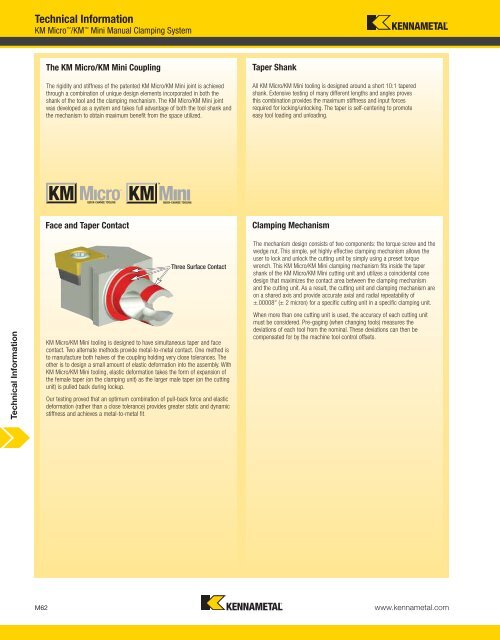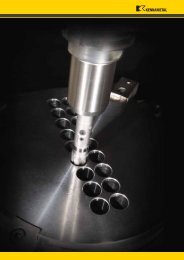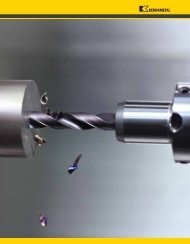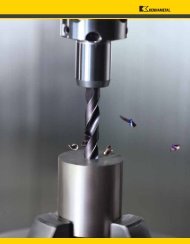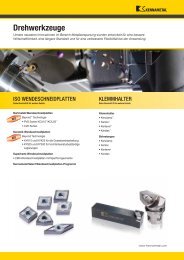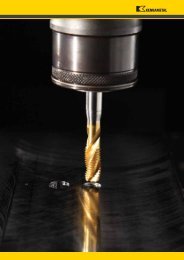Create successful ePaper yourself
Turn your PDF publications into a flip-book with our unique Google optimized e-Paper software.
<strong>Technical</strong> <strong>Information</strong><br />
<strong>Technical</strong> <strong>Information</strong><br />
KM Micro /KM Mini Manual Clamping System<br />
The KM Micro/KM Mini Coupling<br />
The rigidity and stiffness of the patented KM Micro/KM Mini joint is achieved<br />
through a combination of unique design elements incorporated in both the<br />
shank of the tool and the clamping mechanism. The KM Micro/KM Mini joint<br />
was developed as a system and takes full advantage of both the tool shank and<br />
the mechanism to obtain maximum benefit from the space utilized.<br />
Face and Taper Contact<br />
Three Surface Contact<br />
KM Micro/KM Mini tooling is designed to have simultaneous taper and face<br />
contact. Two alternate methods provide metal-to-metal contact. One method is<br />
to manufacture both halves of the coupling holding very close tolerances. The<br />
other is to design a small amount of elastic deformation into the assembly. With<br />
KM Micro/KM Mini tooling, elastic deformation takes the form of expansion of<br />
the female taper (on the clamping unit) as the larger male taper (on the cutting<br />
unit) is pulled back during lockup.<br />
Our testing proved that an optimum combination of pull-back force and elastic<br />
deformation (rather than a close tolerance) provides greater static and dynamic<br />
stiffness and achieves a metal-to-metal fit.<br />
Taper Shank<br />
All KM Micro/KM Mini tooling is designed around a short 10:1 tapered<br />
shank. Extensive testing of many different lengths and angles proves<br />
this combination provides the maximum stiffness and input forces<br />
required for locking/unlocking. The taper is self-centering to promote<br />
easy tool loading and unloading.<br />
Clamping Mechanism<br />
The mechanism design consists of two components: the torque screw and the<br />
wedge nut. This simple, yet highly effective clamping mechanism allows the<br />
user to lock and unlock the cutting unit by simply using a preset torque<br />
wrench. This KM Micro/KM Mini clamping mechanism fits inside the taper<br />
shank of the KM Micro/KM Mini cutting unit and utilizes a coincidental cone<br />
design that maximizes the contact area between the clamping mechanism<br />
and the cutting unit. As a result, the cutting unit and clamping mechanism are<br />
on a shared axis and provide accurate axial and radial repeatability of<br />
±.00008" (± 2 micron) for a specific cutting unit in a specific clamping unit.<br />
When more than one cutting unit is used, the accuracy of each cutting unit<br />
must be considered. Pre-gaging (when changing tools) measures the<br />
deviations of each tool from the nominal. These deviations can then be<br />
compensated for by the machine tool control offsets.<br />
M62 www.kennametal.com


